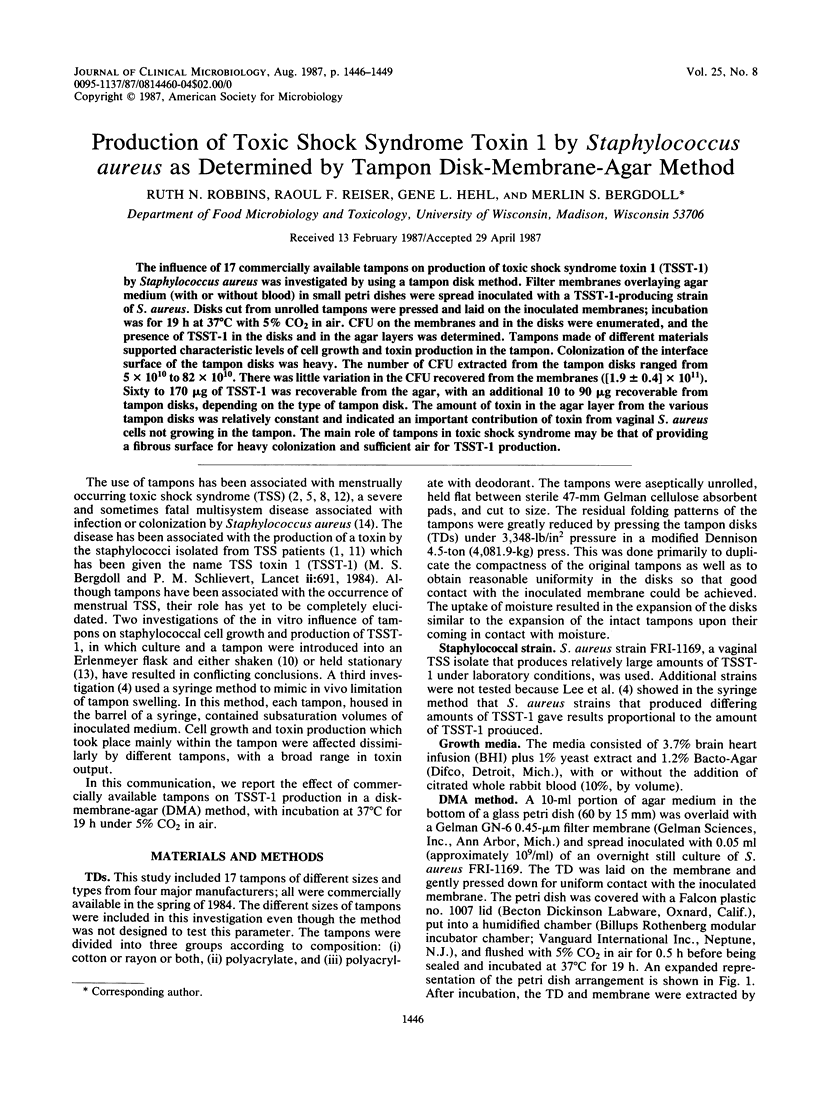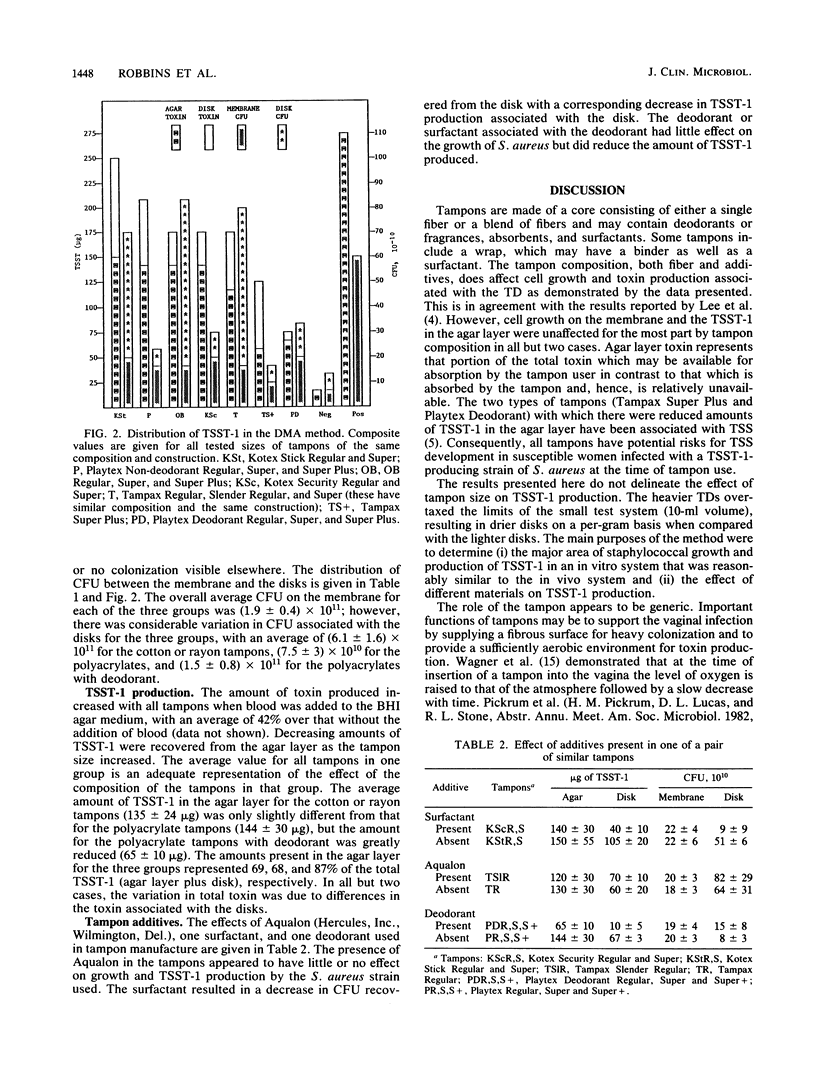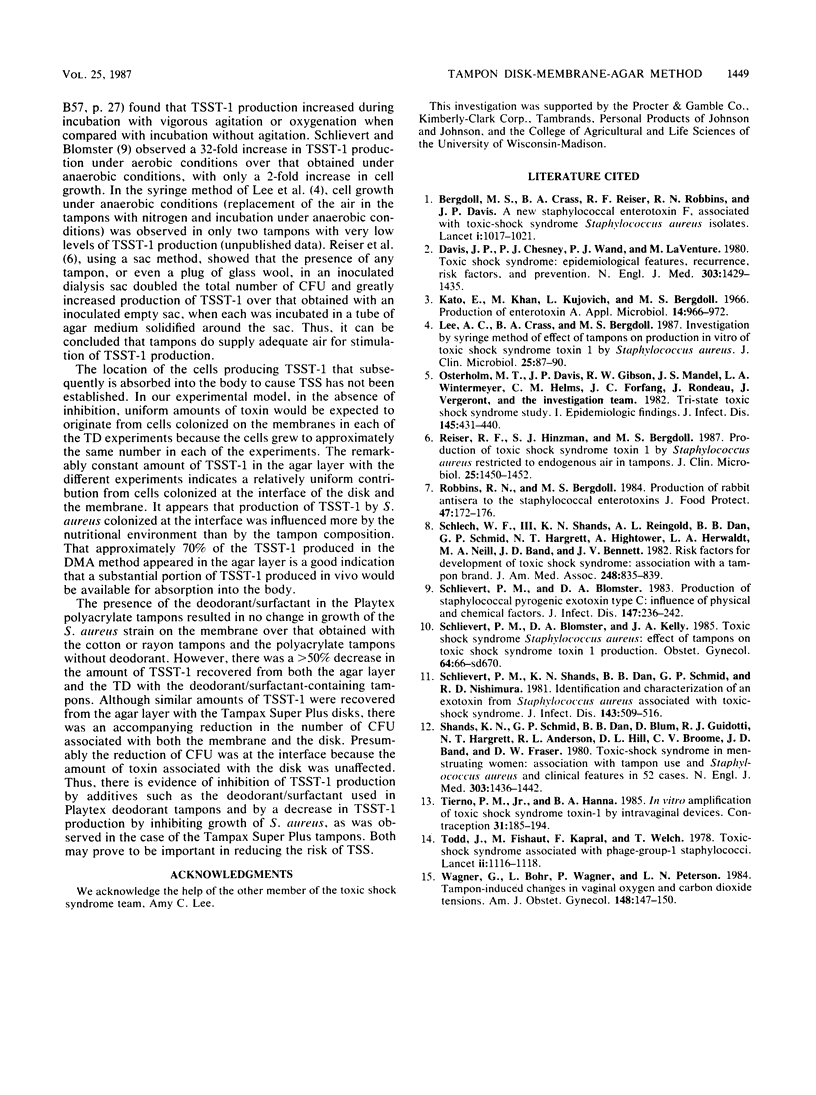Abstract
The influence of 17 commercially available tampons on production of toxic shock syndrome toxin 1 (TSST-1) by Staphylococcus aureus was investigated by using a tampon disk method. Filter membranes overlaying agar medium (with or without blood) in small petri dishes were spread inoculated with a TSST-1-producing strain of S. aureus. Disks cut from unrolled tampons were pressed and laid on the inoculated membranes; incubation was for 19 h at 37 degrees C with 5% CO2 in air. CFU on the membranes and in the disks were enumerated, and the presence of TSST-1 in the disks and in the agar layers was determined. Tampons made of different materials supported characteristic levels of cell growth and toxin production in the tampon. Colonization of the interface surface of the tampon disks was heavy. The number of CFU extracted from the tampon disks ranged from 5 X 10(10) to 82 X 10(10). There was little variation in the CFU recovered from the membranes ([1.9 +/- 0.4] X 10(11)). Sixty to 170 micrograms of TSST-1 was recoverable from the agar, with an additional 10 to 90 micrograms recoverable from tampon disks, depending on the type of tampon disk. The amount of toxin in the agar layer from the various tampon disks was relatively constant and indicated an important contribution of toxin from vaginal S. aureus cells not growing in the tampon. The main role of tampons in toxic shock syndrome may be that of providing a fibrous surface for heavy colonization and sufficient air for TSST-1 production.
Full text
PDF



Selected References
These references are in PubMed. This may not be the complete list of references from this article.
- Davis J. P., Chesney P. J., Wand P. J., LaVenture M. Toxic-shock syndrome: epidemiologic features, recurrence, risk factors, and prevention. N Engl J Med. 1980 Dec 18;303(25):1429–1435. doi: 10.1056/NEJM198012183032501. [DOI] [PubMed] [Google Scholar]
- Kato E., Khan M., Kujovich L., Bergdoll M. S. Production of enterotoxin a. Appl Microbiol. 1966 Nov;14(6):966–972. doi: 10.1128/am.14.6.966-972.1966. [DOI] [PMC free article] [PubMed] [Google Scholar]
- Lee A. C., Crass B. A., Bergdoll M. S. Investigation by syringe method of effect of tampons on production in vitro of toxic shock syndrome toxin 1 by Staphylococcus aureus. J Clin Microbiol. 1987 Jan;25(1):87–90. doi: 10.1128/jcm.25.1.87-90.1987. [DOI] [PMC free article] [PubMed] [Google Scholar]
- Osterholm M. T., Davis J. P., Gibson R. W., Mandel J. S., Wintermeyer L. A., Helms C. M., Forfang J. C., Rondeau J., Vergeront J. M. Tri-state toxic-state syndrome study. I. Epidemiologic findings. J Infect Dis. 1982 Apr;145(4):431–440. doi: 10.1093/infdis/145.4.431. [DOI] [PubMed] [Google Scholar]
- Reiser R. F., Hinzman S. J., Bergdoll M. S. Production of toxic shock syndrome toxin 1 by Staphylococcus aureus restricted to endogenous air in tampons. J Clin Microbiol. 1987 Aug;25(8):1450–1452. doi: 10.1128/jcm.25.8.1450-1452.1987. [DOI] [PMC free article] [PubMed] [Google Scholar]
- Schlech W. F., 3rd, Shands K. N., Reingold A. L., Dan B. B., Schmid G. P., Hargrett N. T., Hightower A., Herwaldt L. A., Neill M. A., Band J. D. Risk factors for development of toxic shock syndrome. Association with a tampon brand. JAMA. 1982 Aug 20;248(7):835–839. [PubMed] [Google Scholar]
- Schlievert P. M., Blomster D. A. Production of staphylococcal pyrogenic exotoxin type C: influence of physical and chemical factors. J Infect Dis. 1983 Feb;147(2):236–242. doi: 10.1093/infdis/147.2.236. [DOI] [PubMed] [Google Scholar]
- Schlievert P. M., Shands K. N., Dan B. B., Schmid G. P., Nishimura R. D. Identification and characterization of an exotoxin from Staphylococcus aureus associated with toxic-shock syndrome. J Infect Dis. 1981 Apr;143(4):509–516. doi: 10.1093/infdis/143.4.509. [DOI] [PubMed] [Google Scholar]
- Shands K. N., Schmid G. P., Dan B. B., Blum D., Guidotti R. J., Hargrett N. T., Anderson R. L., Hill D. L., Broome C. V., Band J. D. Toxic-shock syndrome in menstruating women: association with tampon use and Staphylococcus aureus and clinical features in 52 cases. N Engl J Med. 1980 Dec 18;303(25):1436–1442. doi: 10.1056/NEJM198012183032502. [DOI] [PubMed] [Google Scholar]
- Tierno P. M., Jr, Hanna B. A. In vitro amplification of toxic shock syndrome toxin-1 by intravaginal devices. Contraception. 1985 Feb;31(2):185–194. doi: 10.1016/0010-7824(85)90033-2. [DOI] [PubMed] [Google Scholar]
- Todd J., Fishaut M., Kapral F., Welch T. Toxic-shock syndrome associated with phage-group-I Staphylococci. Lancet. 1978 Nov 25;2(8100):1116–1118. doi: 10.1016/s0140-6736(78)92274-2. [DOI] [PubMed] [Google Scholar]
- Wagner G., Bohr L., Wagner P., Petersen L. N. Tampon-induced changes in vaginal oxygen and carbon dioxide tensions. Am J Obstet Gynecol. 1984 Jan 15;148(2):147–150. doi: 10.1016/s0002-9378(84)80165-9. [DOI] [PubMed] [Google Scholar]


